Our Heritage
If the axiom that ‘the future builds on the foundation of the past’ holds true, then the palpable temperament of innovative law established by over a century of business certainly explains why the law firm Adams & Adams commands such a leading position in the southern hemisphere.
Established in 1908 by Harry Adams, the firm’s Partners have never been satisfied with practicing law ‘by the book’ – rather they have demanded and inspired an ethos that ‘writes the book’ – a way of securing the firm’s future by preparing and blueprinting it in the present.
In 114 years Adams & Adams has gained an affluence of 69 active and experienced partners, each one inspired by the spirit and energy of brothers Harry and EV Adams.
1875 – 1900
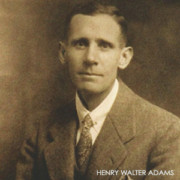

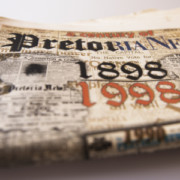

The law firm owes its name to two sons of the Reverend Harry Adams, who came to the Transvaal in 1875 to advance the cause of the Church of England. Henry (Harry) Walter Adams born in Lydenberg, Transvaal, in 1882, while brother, Eustace Victor (EV) was born in Barberton in 1888.
In 1897, Jemima Adams returns to England with family. The younger son, Eustace Victor, later wrote: “My mother conducted a boarding house so well that she was able to take us five children to England for Queen Victoria’s Diamond Jubilee (in 1897) and placed Harry and Melville at school there, and sent my sisters to a finishing school in Brussels.” This is one of the first recorded notes in the archives of the firm.
Two of the sons, Harry and Eustace (later known affectionately as EV), were sent to public school in England and then went up to Cambridge University. He was then articled as an engineer with the South Eastern and Chatham Railway Company.
1900 – 1910



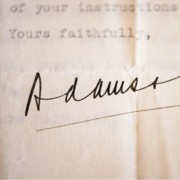
1902, the Transvaal Patent Law is enacted, and in 1905, after completing two and a quarter of his three year’s articles his doctor advised Harry to return to South Africa because he feared that he may contract tuberculosis. He decided there was no future in the Transvaal for a civil engineer, his career of choice, and became an attorney. Harry returned to South Africa, and articled at Messrs Findlay, MacRobert & Niemeyer.
Within a few days of admission to the profession, in July 1908, Harry opened his own office in Bureau Lane, Pretoria, under the name HW Adams, Solicitor. On 2nd July 1908 he had become registered as a patent agent. He married Mary Crawford, daughter of the Honourable Hugh Crawford, then Speaker of the Transvaal Parliament
1910 – 1920
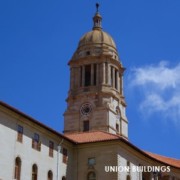
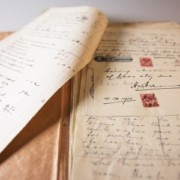
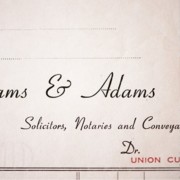
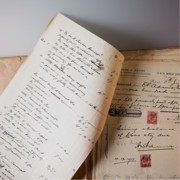
The Union of South Africa was formed in 1910 but, for a time, each province had its own patent, trade mark and copyright laws. This meant that foreign companies like General Motors and the Motion Picture Patents Company (both founded in 1908), had to apply separately in the Cape, Natal, Transvaal and Orange Free State for their patents and trade mark registrations.
During the period before the First World War his patent practice grew steadily. One of his interesting cases, which has been reported, was Ussher vs Chamber of Mines 1912 TPD 1075. In this case his client, Ussher had invented a method of laying dust in mining operations and had applied for a patent therefore. This application was opposed by the Chamber of Mines, but unsuccessfully, because the patent was duly granted.
In 1916, the government passed the Act on Patents, Designs, Trade Marks and Copyright, replacing all provincial legislation. This made it possible to file in Pretoria a single application for a patent, trademark or design registration, covering the entire Union.
Having assisted the government with introducing the new intellectual property law, he published a booklet entitles ‘Handbook on the Law and Practice of Patents, Designs, Trade Marks and Copyright in the Union of South Africa’ in November 1916. He indicated that the booklet was especially for use by patent agents abroad and distributed it free of charge to leading agents throughout the world. The result, according to EV Adams, was that the firm shot ahead of other firms of patent agents.
Harry Adams kept open a position for EV. When the latter returned from German East Africa in 1917, the two brothers formed a partnership in July 1917 – and so the first Adams & Adams partnership was born. EV ruefully said that, even though he was an advocate with an LLB and thought he would teach his brother Harry the law, the shoe was definitely on the other foot from the start.
Because of his engineering training, Harry specialised in patent and trade mark work, while EV did conveyancing and general legal work.
1920 – 1940
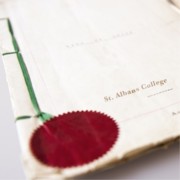
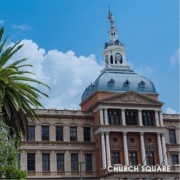
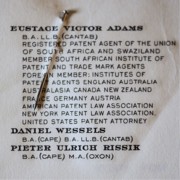

In 1922 Harry went to Europe, the United States and Canada to visit the firm’s intellectual property correspondents – the first of the relationship-building trips that are still undertaken by Adams & Adams.
Harry had a reputation for being completely honest and straightforward and was an extremely hard worker. Committed to good structures, he believed a firm could keep ahead of competitors by implementing advanced and efficient systems.
In 1923 the firm moves to larger offices in the Marais Building on Bureau Lane, Pretoria. Harry Adams dies in 1928. EV’s brother-in-law, Daniel Wessels is admitted as a partner. He would serve as partner to 1942.
Ulrich Rissik is admitted as a Partner to the firm. He would serve as partner until 1936. The firm moves offices again – this time to the fourth floor of the Standard Bank Building on Church Square.
In 1939, EV’s nephew Melville (Mello) MacRobert is admitted as a Partner to the firm and serves until 1980. Mello MacRobert joined the Union Air Force and become a fighter pilot. After serving in Egypt in 1941/42, he joined RAF Bomber Command and operated in India and Burma. MacRobert was to serve the firm for just over 40 years, until his death in 1980. He was senior partner and chairman from 1958.
He not only had a distinguished academic career, he was known for an enduring commitment to society and a loyalty to his country and was a strong believer in the benefits of education. In 1963, he was one of the founders of St. Albans College in Pretoria.
When Britain declared war on Germany in September 1939, followed three days later by the Union of South Africa, EV decided that he was too old to ‘go campaigning as a trooper again’ and that he would do better for the country by letting his two partners go to war while he kept the firm going.
1940 – 1960
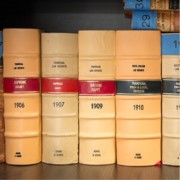

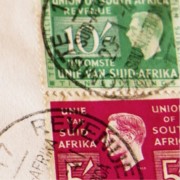
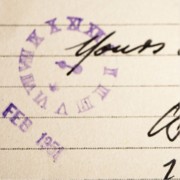
In July 1940, Daniel Wessels joined the Transvaal Scottish Regiment as a lieutenant. In 1946, Harry’s son, Neville is admitted as a partner and would serve until 1951 when he resigned and joined Savage & Jooste Attorneys.
1947, Guy Braithwaite is admitted as a partner and would serve until 1962.
1952, Denis Oldridge joins as a partner and soon became head of the Commercial, Property and Litigation Department, succeeding Mello MacRobert as chairman of the firm. Oldridge served as partner until 1984.
An ever-expanding Adams & Adams moves offices again in 1954 – to the fourth floor of the Van der Stel Building in Pretorius Street, Pretoria.
1956, Jan Steyn is admitted as a partner and would become head of the Patent Department, then succeeding Oldridge as Chairman. He served until 1987.
During 1958 Eustace revised and re-edited the second edition of the Adams & Adams Handbook, in view of the new Patents Act No. 57 of 1952. He omitted all references to copyright from this edition, because copyright did not require registration and few enquiries were received. Because about two thirds of the firm’s total work concerned patents and trade marks, it was considered to be very advisable for partners also to be admitted as patent agents or otherwise to receive some technical training in fields such as engineering, chemistry and science. He therefore suggested Mello should qualify as a patent agent, and in 1953 Mello did so.
EV Adams retired in 1958. His dislike of the National Party government of the day induced him to move to Salisbury in what was then Southern Rhodesia, though he remained a sleeping partner in the firm until his death in Cape Town in 1968.
1960 – 1980

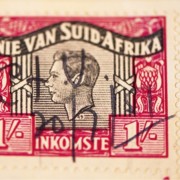
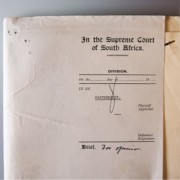
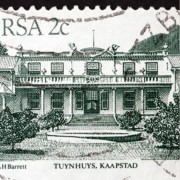
In 1961, the Union of South Africa becomes the Republic of South Africa following a referendum and country becomes increasingly isolated politically and economically.
Adams & Adams welcomes five new Partners, and the firm moves to the Allied Building in Pretorius Street, in 1962, while in 1963, Esme du Plessis becomes the first woman to serve articles of clerkship at Adams & Adams and the first woman in South Africa to qualify as a patent agent.
Chris Slabbert and Esme du Plessis become partners at Adams & Adams. Esme du Plessis was the first female partner at Adams & Adams in 1966.
1967, Don MacRobert and Bill Schuurman join as partners, with four new partners in 1972. Shortly thereafter, a voting, shareholding and retirement system is introduced to the firm’s Partnership arrangement. It was considered a revolutionary move among South African law firms at the time. The 1970s also saw some interesting inventors and inventions in South Africa.
Between 1975 and 1981, the firm’s growth allows for the addition of seven new Partners and the firm relocates to new offices in Paul Kruger Street. In 1978, a branch office is opened in Cape Town. The system of independent ‘homeland states’ by the Apartheid government requires that IP registrations be filed in each of these ‘states’, including South Africa. Attorneys in these ‘states’ are appointed by Adams & Adams to act as correspondents.
1980 – 2000
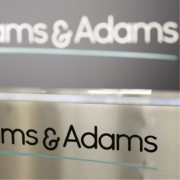
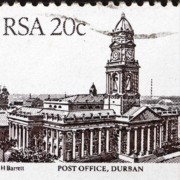

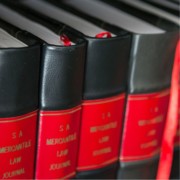
Eighteen new Partners were admitted between 1982 and 1989.
In 1983, a branch office is opened in Durban, and the firm moves to new premises in Pretoria in 1985.
Twelve new Partners joined between 1990 and 1996. In 1992, Esme du Plessis becomes the first woman to be elected to the Law Society Council, that of the Transvaal Law Society. She is then elected president of the Transvaal Law Society in 1995. She is also elected as president of the International Association for the Protection of Intellectual Property (AIPPI) South African Group.
2000 – 2016
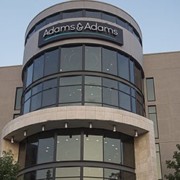
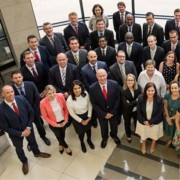
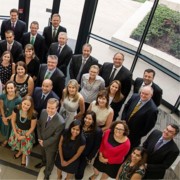

Adams & Adams is regarded as the largest intellectual property law firm in Africa and this is proved by the addition of 52 new partners between 1997 and 2008.
In 2008, the firm celebrates 100 years of existence – over the century, Adams & Adams has grown in size and stature, both locally and internationally, and has made substantial progress in both gender and race equity.
Adams & Adams moves to a new Head Office in Lynnwood, Pretoria in 2012 and the IP practice of Bowman Gilfillan is merged with Adams & Adams. The firm also opens offices in Tanzania and Burundi, and an OAPI office in Cameroon. The African footprint of Adams & Adams steadily increases with new offices and agents across the continent.
A year later, Adams & Adams holds the first Africa Agents Meeting in Pretoria, welcoming law professionals and agents from many African countries in a bid to share information and legal developments on the continent. In 2014 Meeting would be cancelled due to an Ebola outbreak in West Africa, but would again be successfully hosted in 2015.
The firm launches a new publication – Commercial Law in Africa, in 2015
2016 – 2023

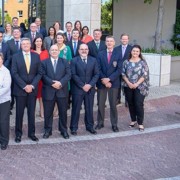
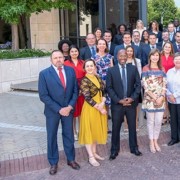

In the firm’s constant quest to meet the legal needs of a 21st century marketplace and in celebration of our passion for, and our work in Africa, Adams & Adams launched a number of new products and services – part of our 110-year anniversary pledge to constant innovations and changes that reflect the firm’s goals, heritage and identity.
In 2018, Adams & Adams adopted the new .africa web domain and introduced products such as IP Connect and Kipanga Watch Service. The new integrated legal forensics service, Adams Forensics, was also launched. And in 2019, the partners proudly announced the introduction of the Adams Africa Advisory. In a first for our continent, the Adams.Africa Advisory offers a comprehensive range of economic, political and legal reports, aimed as providing accurate information and a precise frame of reference for brand expansion and protection in all of Africa’s jurisdictions.
In 2023 Adams & Adams is proud to say that the firm has continued its award-winning work in Intellectual Property and Corporate & Commercial services. Adams & Adams is combining this consistent excellence in the work with a new goal and commitment for the future.
2024

In 2024 the firm is re-launching their brand strategy to pursue the new goal they are dedicated to: Realise African Enterprise.
This call to action for the firm speaks to who Adams & Adams is.
Adams & Adams is more than just a business. It is an enterprise. An enterprise is an organisation with a mission, values, and ambition. Their mission is to help connect Africa with the world and the world with Africa. It is about seeing all clients as their own enterprise, with unique ambitions that have the right to the best legal representation. Adams & Adams is pe


